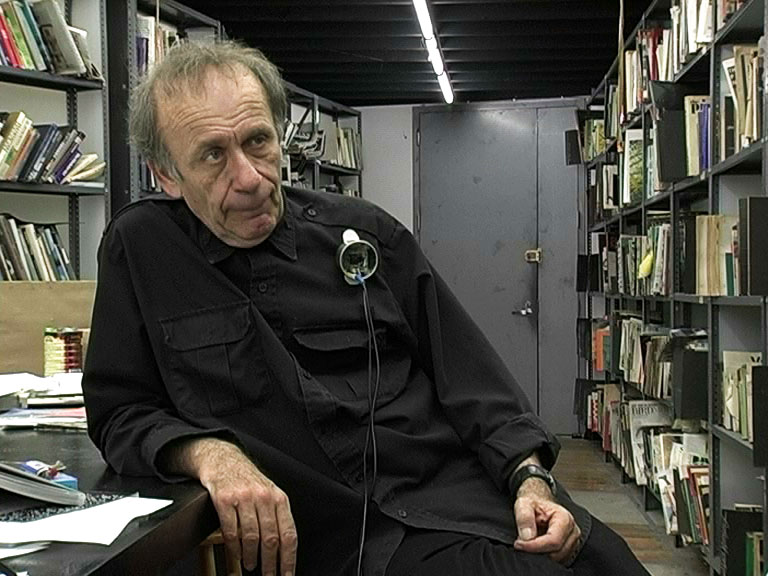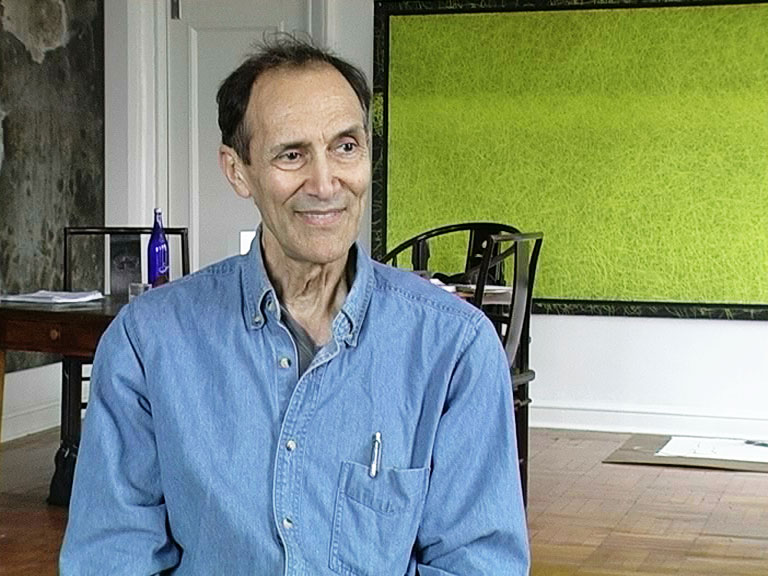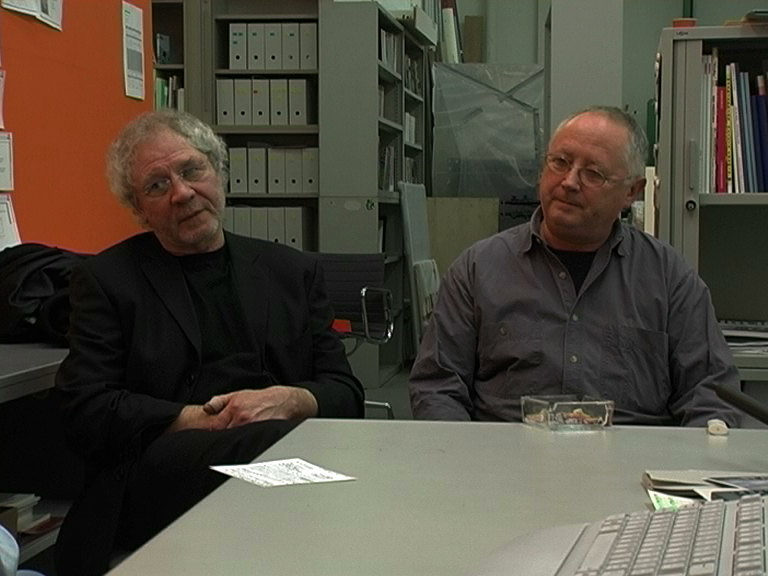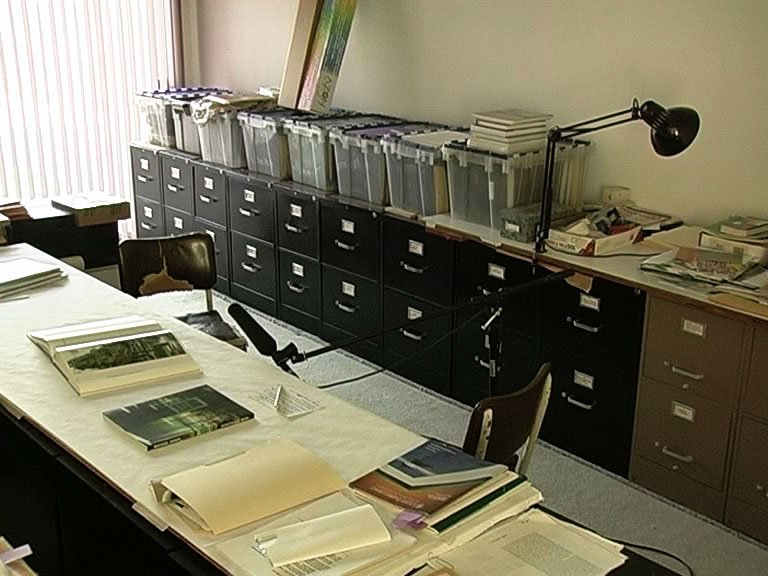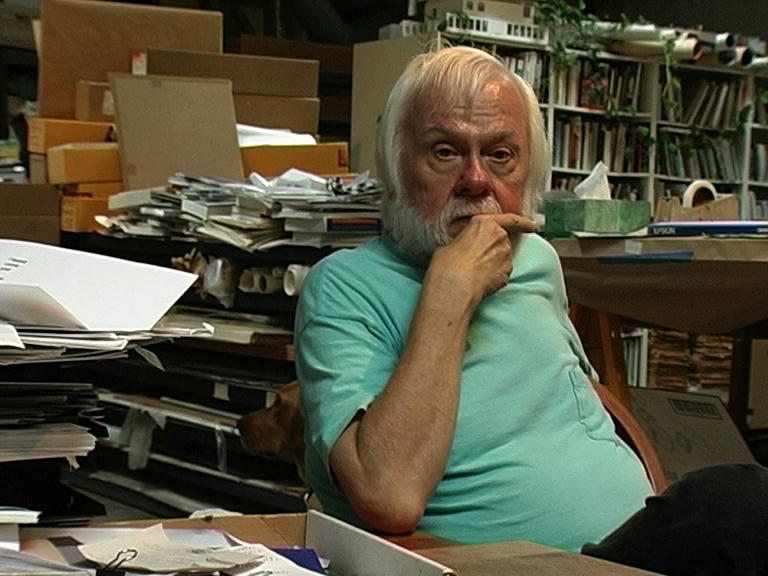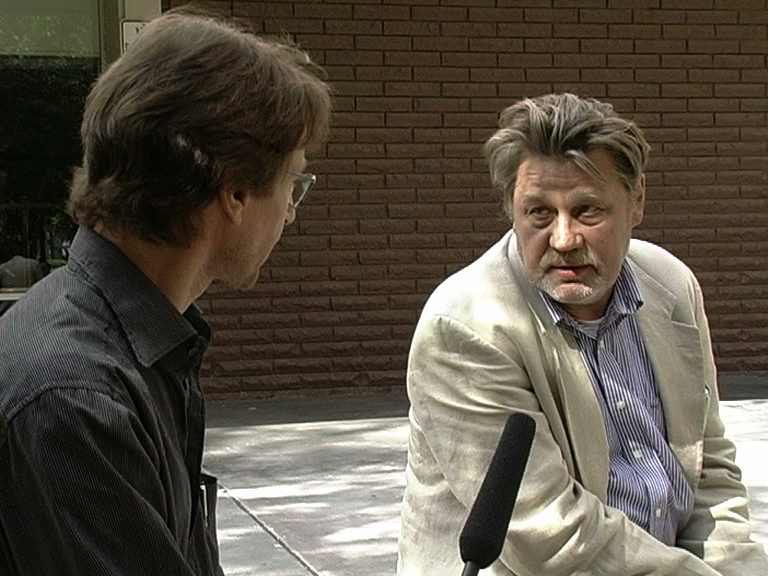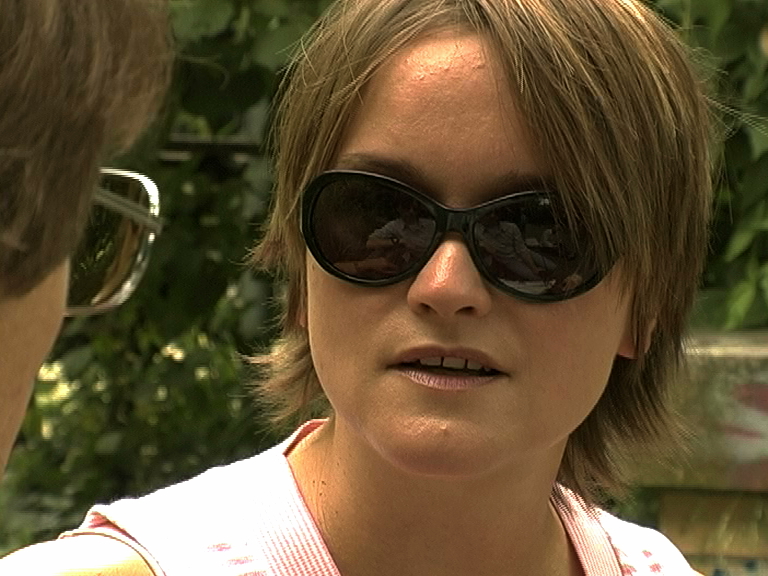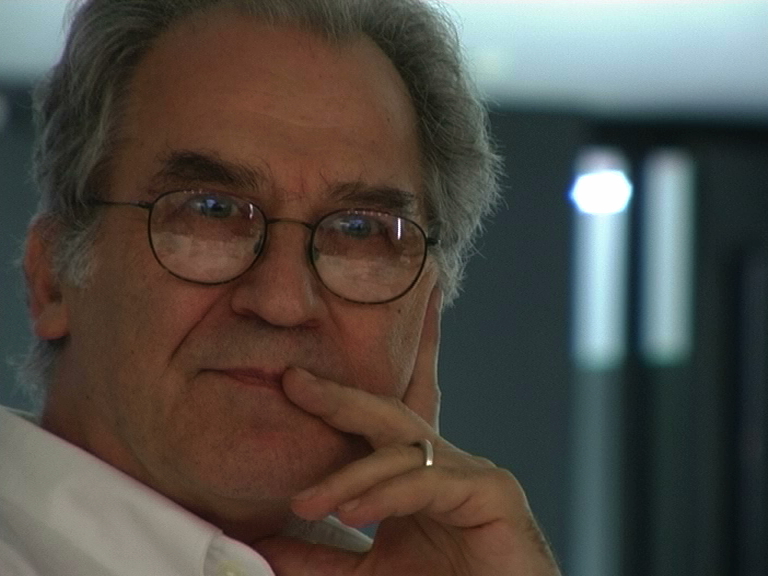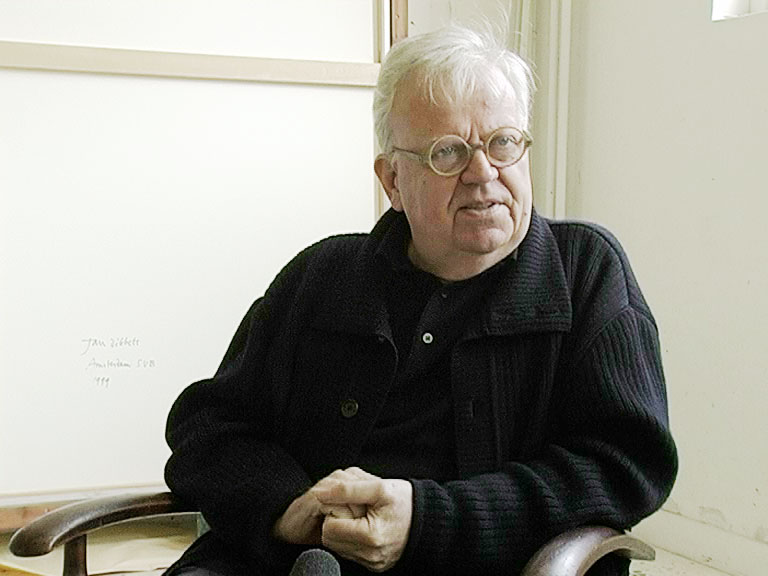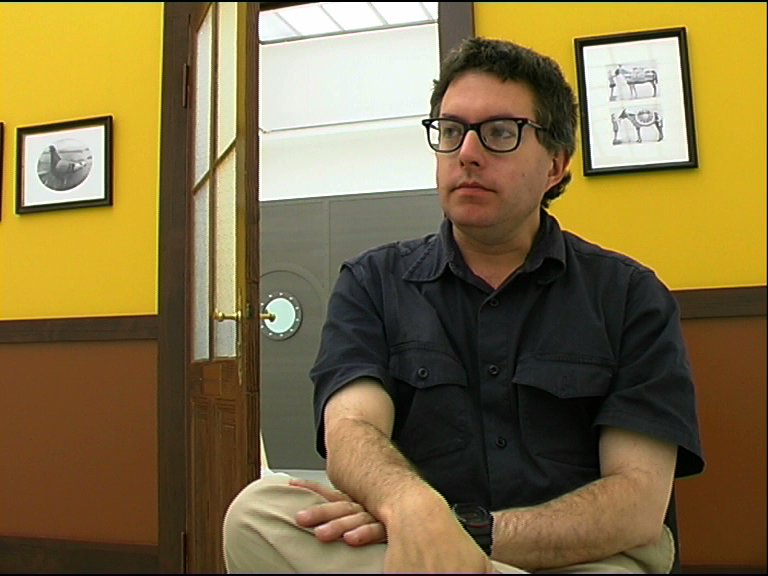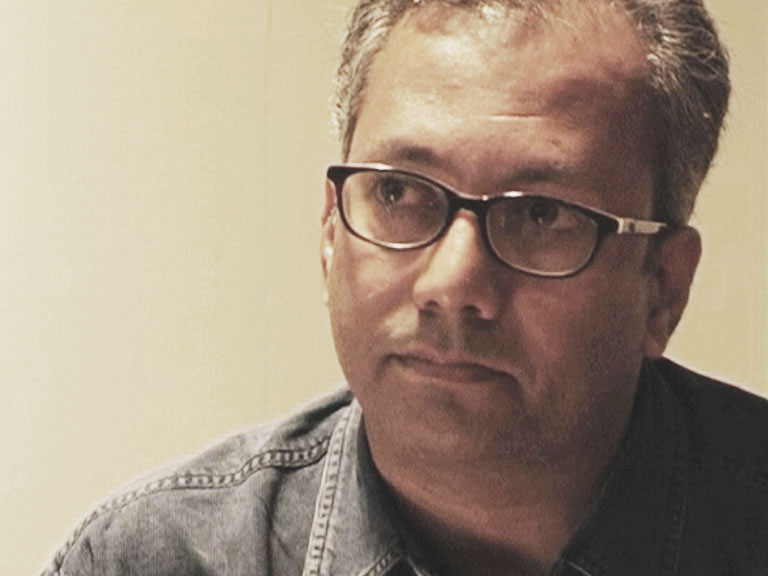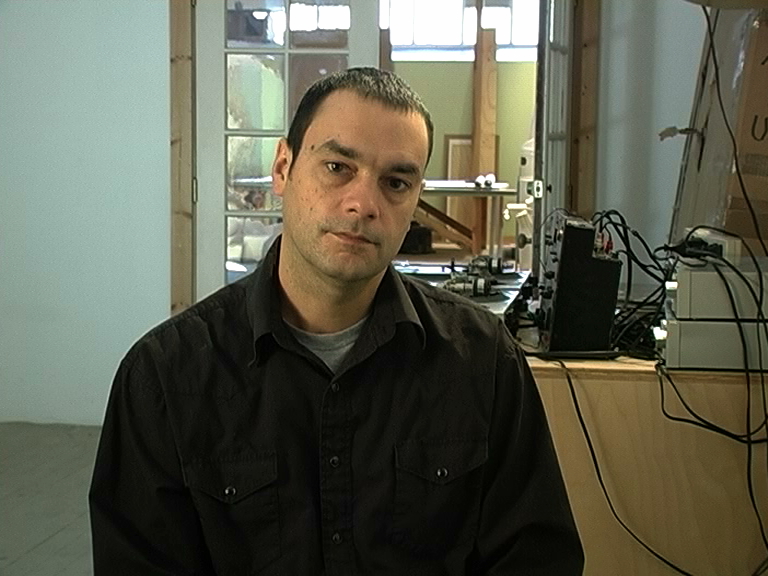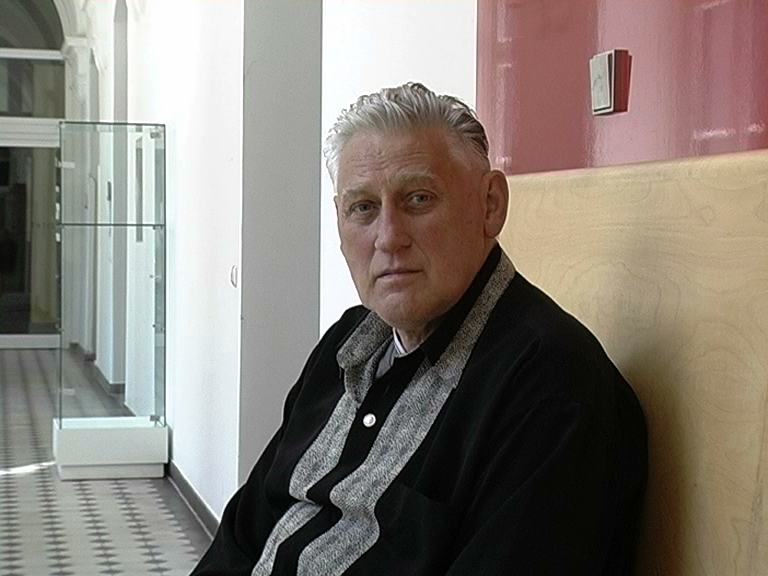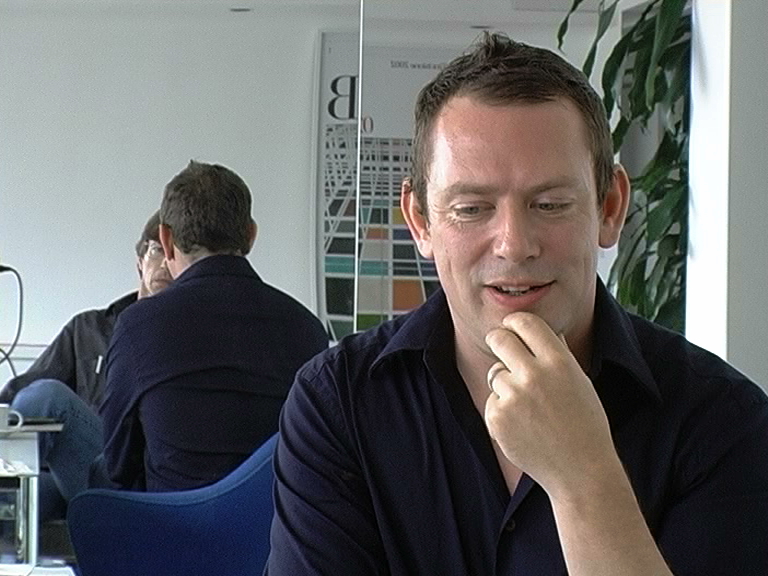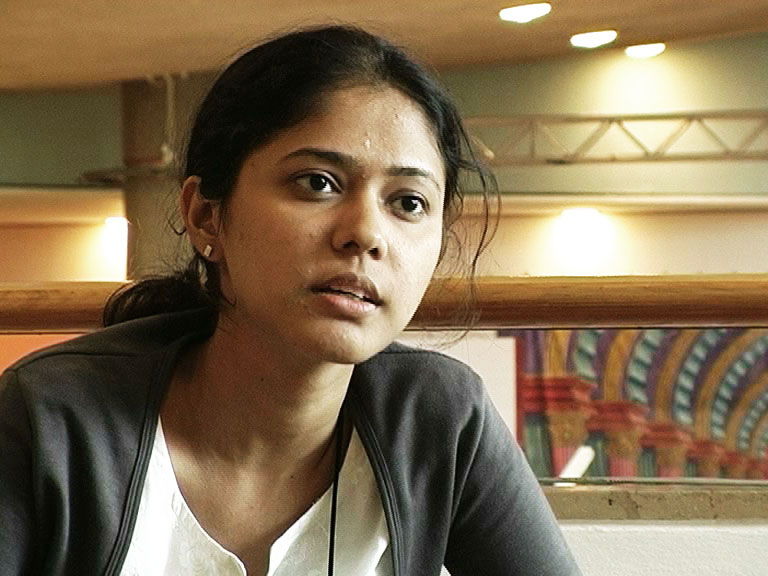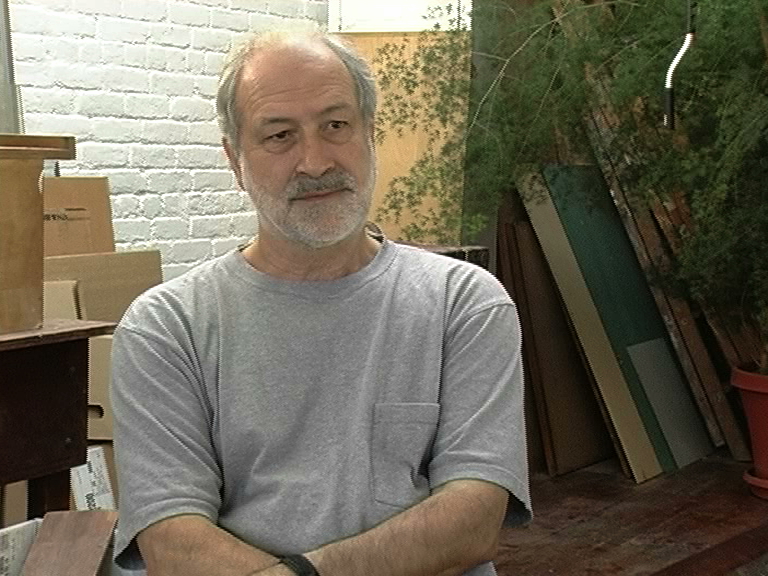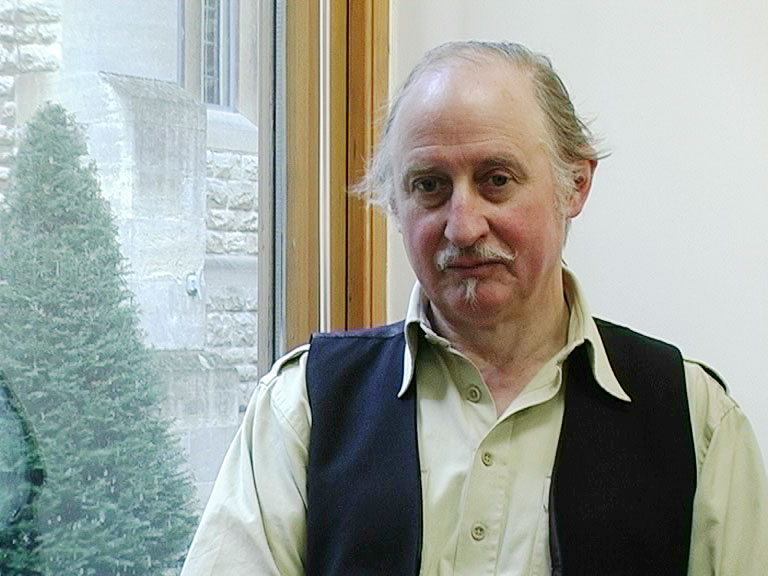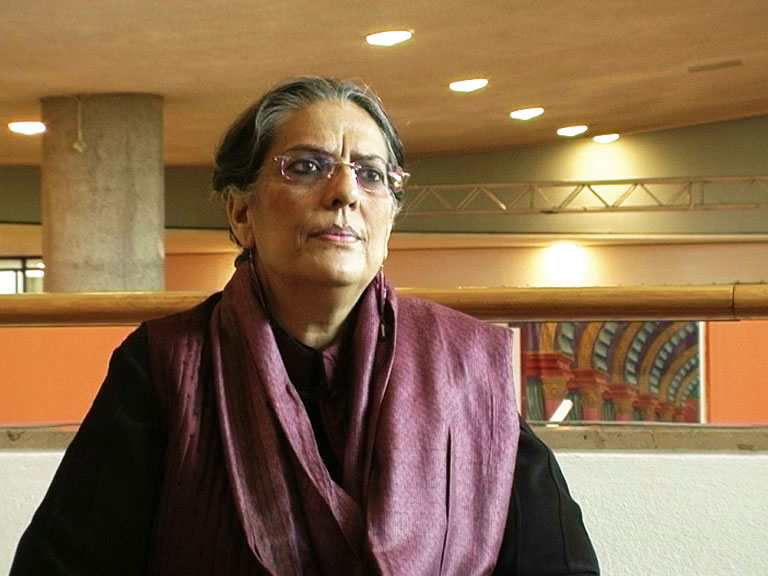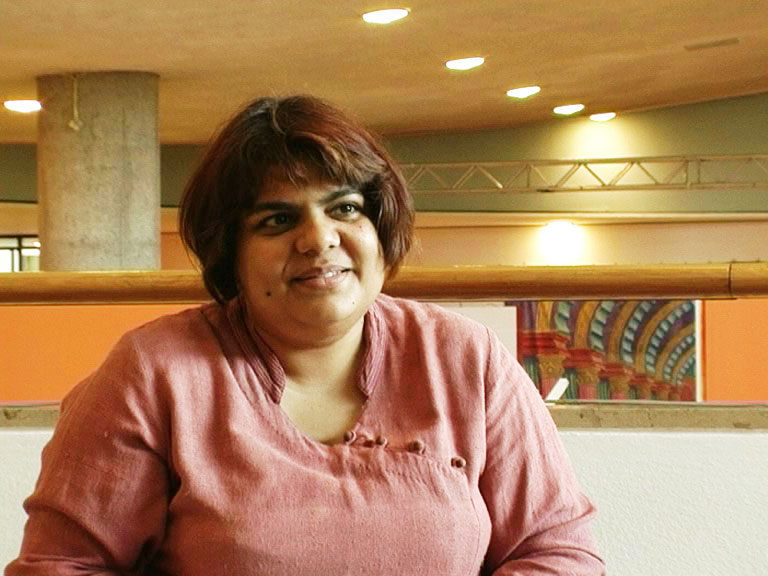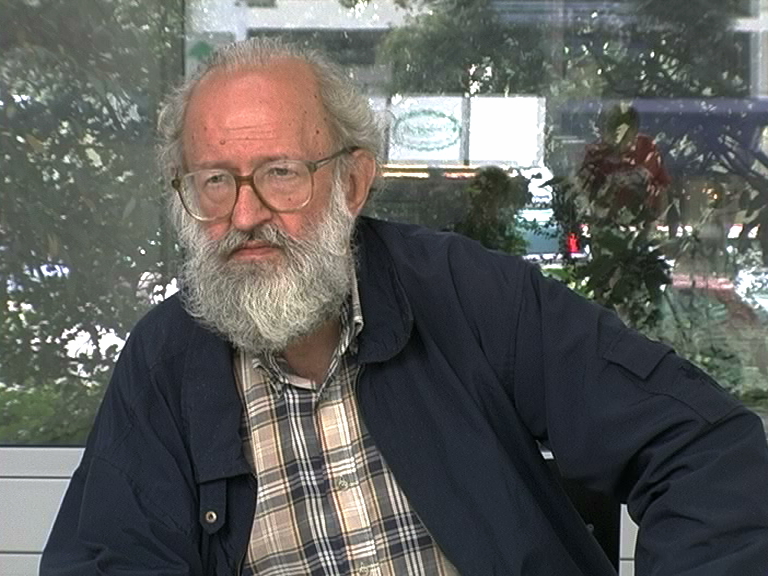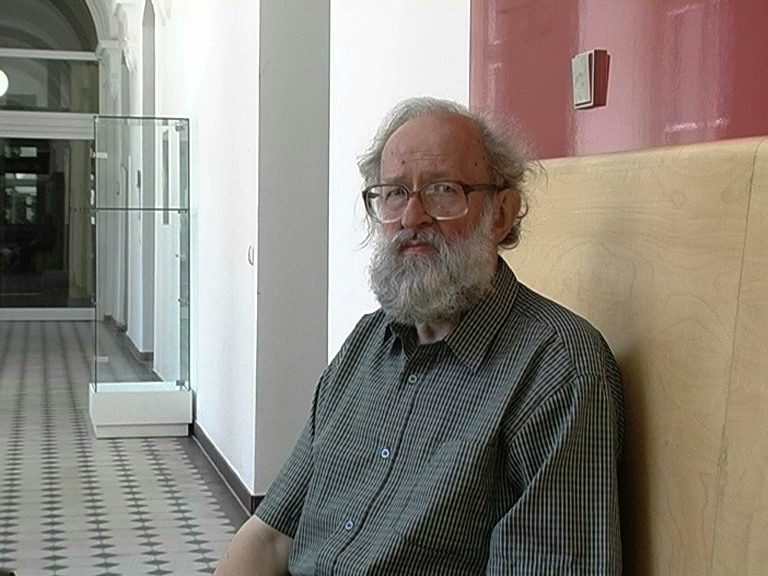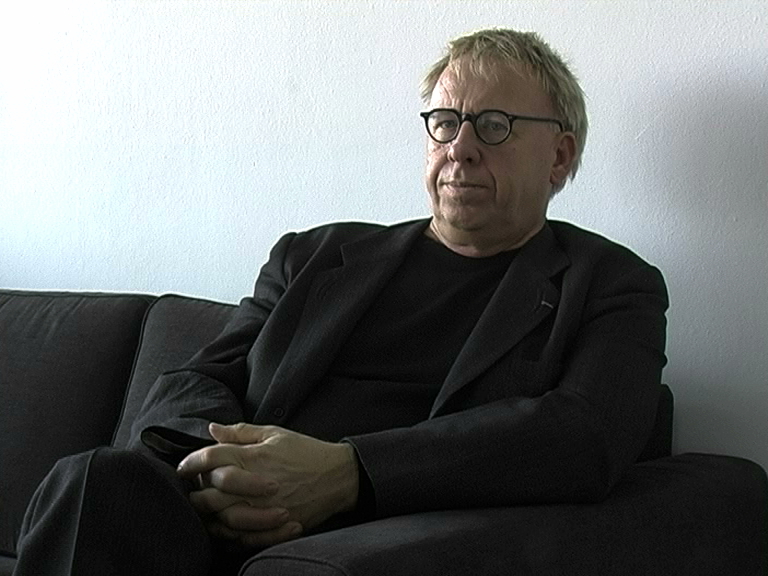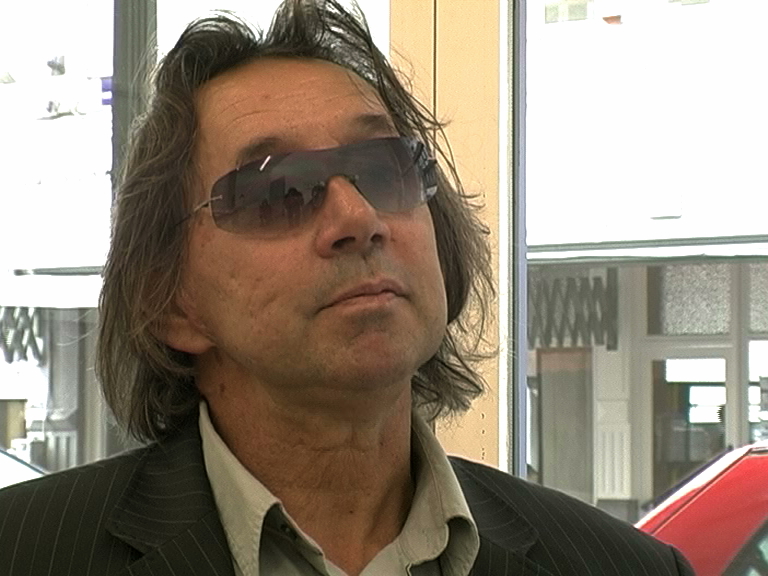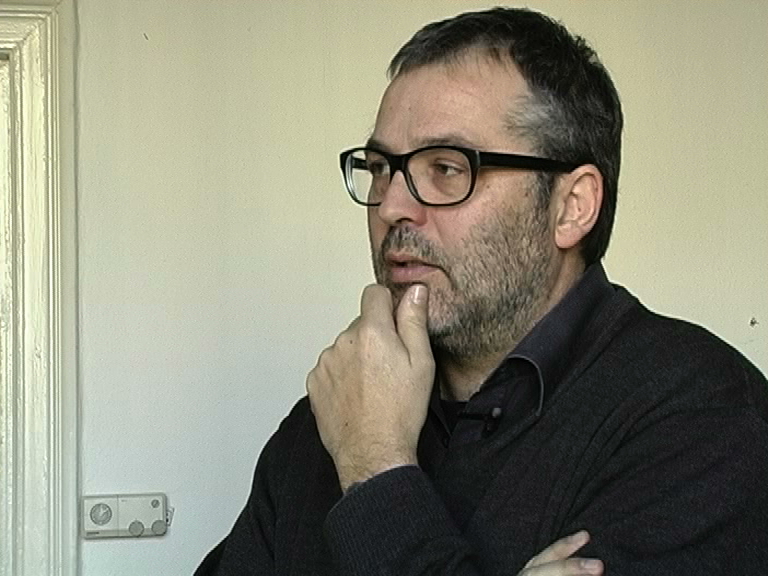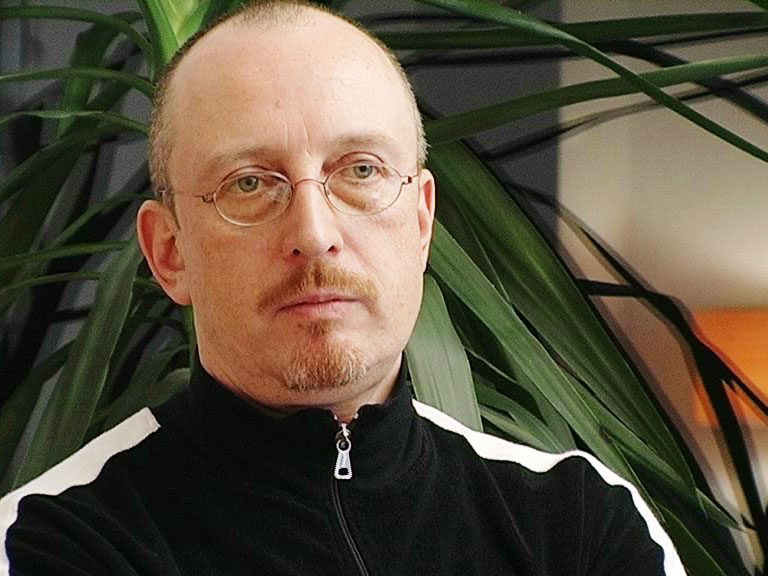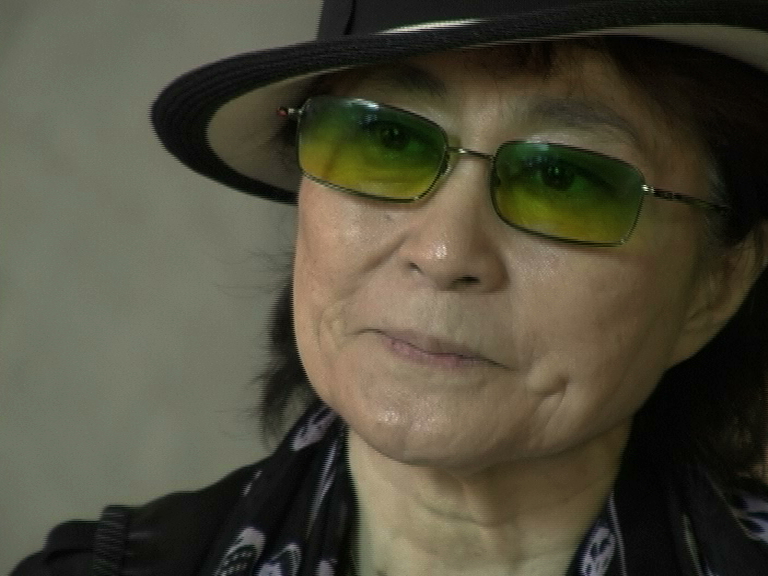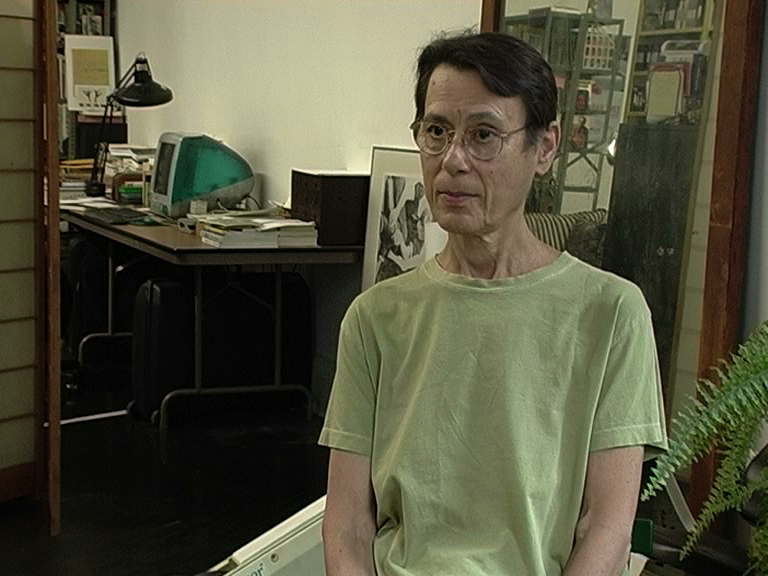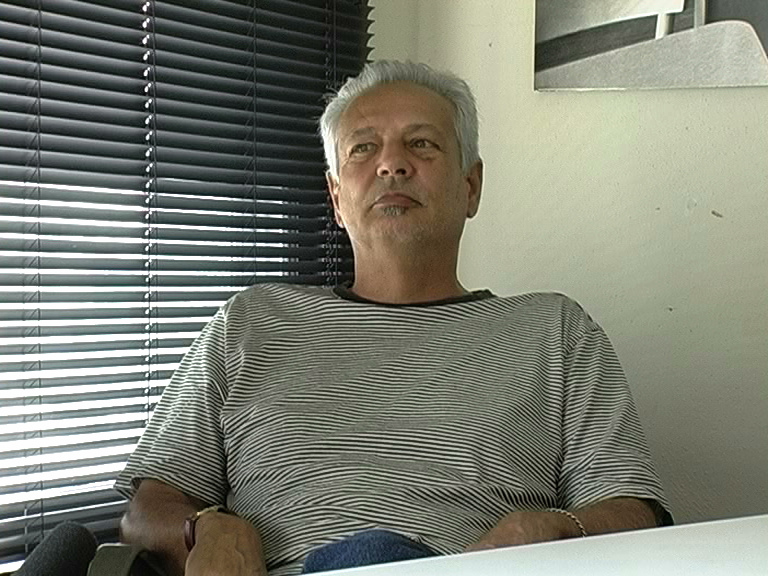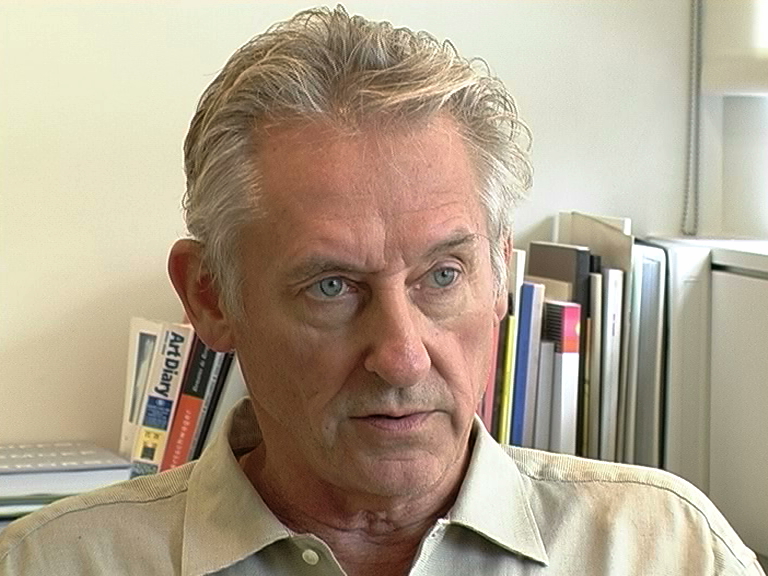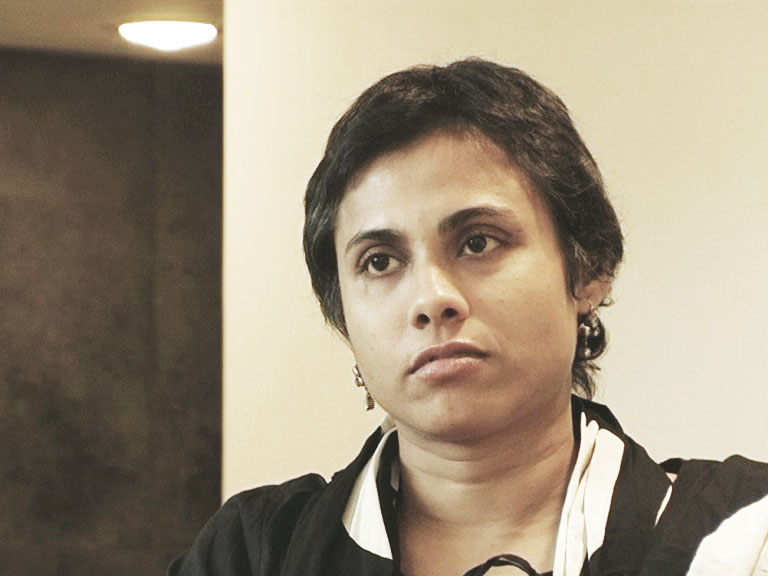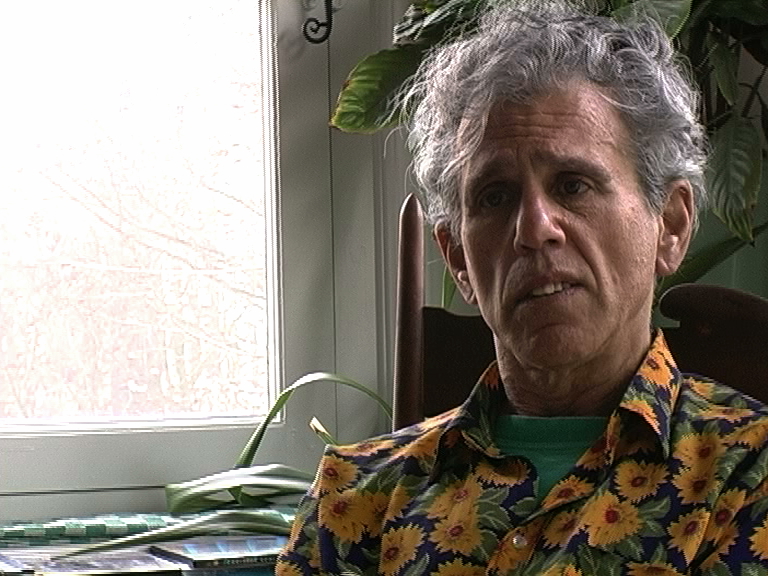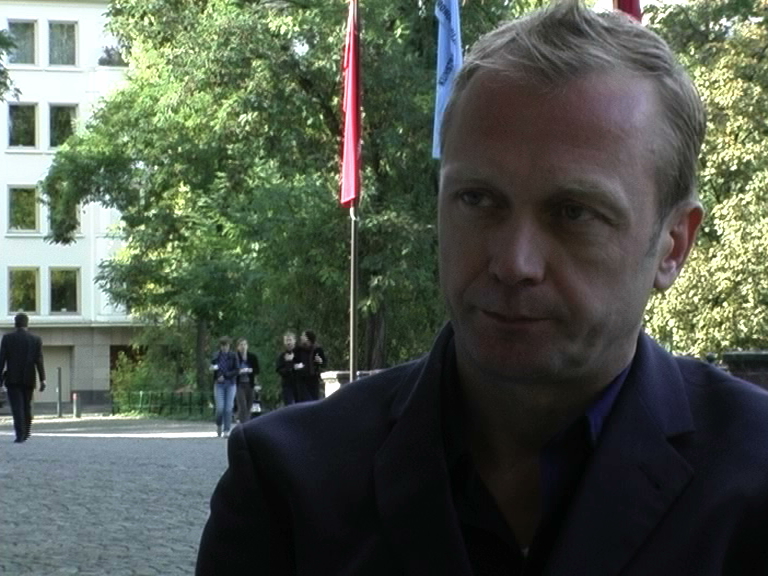S.R.: How do you conceive your own work?
A.D.: Yes, you see my work has gone through many changes in the last few years, and I feel that it’s strange that I conceive many things simultaneously, very diverse and different style of working methods I kind of attempt. And I think somehow I’m quite successful because I can see the reaction of my artist friends and from other people and bysically enjoy.
S.R.: We have to change the camera a bit…
A.D.: So I know from classical to popular, from very tiny to large water colours, to works on rolling shutters, shop shutters or the installation which is here in the House of World Culture, the cabinets, all this kind of work I have been doing, and from figurative to abstraction. Some of my most recent work which nobody has seen yet, somehow I’m moving towards pure abstract painting. I wonder sometimes myself, that how I do. But basically it’s the city which gives me a boost. I was born and I was brought up in Bombay, and I live there in a city like Bombay which is a true metropolis. You know in a city like Bombay you come out of your home and you are bombarded by diverse experiences. All kinds of things from noise and sound, immense poverty and immense rich, utmost equally kind of appeals you, you see them and meet them. So I think it is the living in the city. I often say that if would have been born and brought up in a small town I would have been a very different kind of an artist. But because it is a mega metropolis like Bombay which kind of allows me to do the kind of work I do. It’s also that I’ve certain aspects, because I feel that painting or any art it is a technical thing as well. It’s not just an idea which is in the air, you have to resolve it visually. Technically I am probably some kind of sound artist and I can sort of do it the way I conceive it. These are some of the points about my own work, how I conceive it.
S.R.: …You have so many approaches. What was the strongest influence on your work?
A.D. Yes, I feel that I have gone through various influences, and particularly in my school-of-art-days, David Hockney, the British painter who moved to US, whose work I was quite influenced, his approach to works and life and towards art, and sense of humor. This was something I was quite happy to see those works and to get delight in these works. David Hockney and the Realism, a certain Naturalism was very much a bare in my work. But at the same time, strangely enough, I was also immensely not influenced but inspired by Giordio Morandi and Edward Hopper. But if I were to tell you that American artist, I think I always somehow related myself with them. During the school of art days it was John Johns and Robert Rauschenberg. And their work was really giving me a kind of kick. This is a kind of a new art, it’s modern art, it’s contemporary art, it belongs to the city, it’s the urban-mind. When I see that kind of work I kind of feel very good.
S.R.: Do you have a specific aim in your art, can you focus on a specific aim on your work?
A.D.: Actually I am quite sometimes the way I have been thinking about my own art. I have been quite prolific in recent time, and I feel as if the time is very less, and I have many many ideas, and they are so different. Sometimes I wonder, I’m feeling there is no consistence. You develop in a certain way and you grow; all your life you paint in a certain style and in a certain style. But mine is not like that, so I feel that I get a doubt about myself, maybe I’m not honest, I am not devoted to a specific kind of thing. But inside I know that I have so much passion for what I’m doing, it’s just really passionately feel thing. Otherwise, work shows, if it is not really felt then the work won’t have that kind of rigour and then it will be very superficial. I never felt that kind of thing in my work, but I wonder, that so many layers in which I work. Some day I would like to kind of for six month or a year doing nothing and just think about those things. Every time your aim is also so many points of reference, so many directions that really there is no specific aim.
S.R.: Do you think that conceptual paradigms – if we can speak of something like that – are still in function?
A.D.: I personally feel, sometimes when I see international art and lot of works which denies any thinking process – well, it’s there. Sometimes artists would not like to talk about it. Sometimes there is too much intellectualization. Also, that you feel that a work doesn’t bear the load of the kind of intellectual discourse which artists would provide. But work as a viewer doesn’t appeal you. I think there is too extreme in some of the artists works. I try to you know I prefer some sort of middle part where you know there is a tradition, there is a past. I feel I have a definite relationship with the past. It‘s not that I have nothing to do with what happened, what Giotto did. It matters to me, what Tintoretto did, it matters to me. These at one side I see that as well as in my time, people like Joseph Beuys, or Boltanski and as I mentioned Johns, all these people and their work, some young artists. I think it is definitely the intellectual aspect which matters to me. I think, I like thinking and I am a thinking artist. Also some of my works which had certain reference and quotations, earlier, in last 1995 onwards, where I would call Duchamp in Indian context, oleograph, another kind of oleograph you see in this exhibition, from myth and mythological figures in calendar art. Along with that I would have Joseph Beuys or Georg Baselitz and things like that. It would create a very strange, hybrid image which is sometimes in India, not many people would be aware of say Baselitz or Polke. But artists, yes, they would know. When I show these works here, outside, then they are not familiar with the references, Indian references. It’s a kind of a very strange tension, and I enjoy that they feel very funny and strange, as I said a hybrid sort of image comes up. That’s the thing. But I feel that, I like when there is artist who has to say something in a specific way, it’s not just sort of a, no, I would never use the word gimmick, artists would never do gimmicks. There is an impact, sometimes it’s a question of only giving impact and shock. These things I don’t personally kind of. It is very momentarily, I don’t carry with me, when I see this kind of work, it’s shocking, it has a very solid presence and things like that. But if it’s not intellectually inclined I lose interest soon.
S.R: There is only one more recent question, but I want to tell you some things after. It‘s just more about your daily work.
A.D.: You mean the artist working daily?
S.R.: Yes. For example Duchamp said, I‘m not a painter, I play chess or I read, may be sitting on the internet or what ever. I just want to give an idea what is your typical daily work as an artist. May be you have to organize or to telephone or something.
A.D.: Yes, I do go regularly to my studio around 10:00, 10:30 h; it’s quite a routine. I have an afternoon siesta, I again go in the evening and work till sometimes late night. Living in India is something very different than probably living in the west, and there are so many problems all the time at home. I live in a joint family with my parents, my mother, someone is ill, a small small thing you want to get done like bank and the post or electrical thing or paying bills. I’m lucky enough that my brother does for me all this. But these things are all the time there. Though you would probably like to be in your studio for 24 hours and go on doing your own work, it doesn’t happen. Neighbours all the time would come: what is happening, why are you doing this, earlier you used to do this, that realism was so good, now what does it mean, the shutters and the cabinets. So they come, they talk, it’s a kind of a live, I feel that. I personally feel that I may regularly going to my studio and all but I feel a, I believe in a viewer, a viewer makes art, and definitely I agree with that. I enjoy showing my work, you understand, not to show off, for getting reaction, that how people see, how people sharing basically, how they see and how they respond. And every viewer, I feel, every response is correct. I don’t feel that you have misunderstood my work. No. Whatever response is coming from a viewer is what matters. I live with the people, Stefan. One of my neighbours very soon, very recently, some five years ago they got electricity in the house. Living in a city like Bombay, can you imagine, they had no electricity. They are my first viewer in fact, before the work goes to the gallery or artistic community. I feel that, life is not you own life which you live, you live with many many people.
S.R.: Thank you very much.




